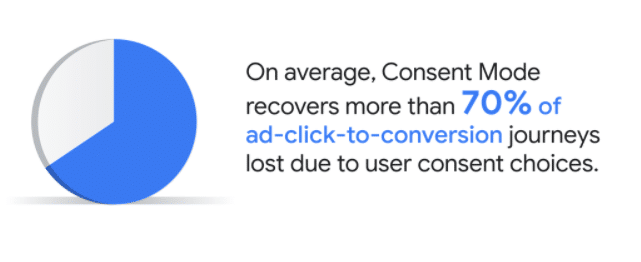Editor's notes
Yesterday, Google published on their blog a post about a feature called Conversion modeling through Consent Mode.
With this feature, Google estimates that you on average can recover more than 70% of ad-click-to-conversion data otherwise lost because users say no thanks to your cookies.
So, essentially what it means is, Google provides you with a privacy-first opportunity to be able to better attribute these conversions back to a specific campaign click in Google Ads.
Link: Cookie Information is a trusted Google partner and you can get Consent Mode with our CMP!
What is Conversion modeling through Consent Mode?
So, last year Google introduced Consent Mode to help advertisers, primarily in Europe, to take a privacy-first approach to digital marketing.
With Consent Mode, you can basically get aggregated, anonymized data from users who visits your website, and maybe also converts, even though they do not accept cookies.
Instead of using cookies (when users decline), Google uses pings to attribute interactions back to Analytics and Ads.
Link: What is Google Consent Mode and how do you get it?
Now, Consent Mode will enable conversion modeling to recover the attribution between ad-click events and conversions measured in Google Ads (for those users having declined cookies).

How does modelling fill the gaps in measurement data?
Google’s Conversion Modeling fills the blanks in your Google measurement products when it’s not possible to see a direct path between ad-clicks and the conversion on your site.
Basically, Google uses machine learning to look at behavior and user journeys from those users who have actually consented to cookies and then predicts missing attribution paths from those who do not consent to cookies.
This will give you a more complete view of your ad spend and the outcomes (conversions) – all while you respect your users’ consent choices.
Now, Google has made a calculation on what it really means for you. They estimate 50% will not consent to cookies. However, our consent rate on average is much higher, a whopping 73,88%.
So, we took the Google calculation and put in our own data to give you an idea of what you get with our Consent Solution and Consent Mode.
Get started:
Getting insights into otherwise lost data will be vital for marketeers who want to know the effectiveness of their marketing efforts and prioritize a privacy-first approach to marketing.
That means, using anonymized data to predict the path from ad-click to conversion on your site.
With Conversion Modeling and Consent Mode, you will be able to see reports in Google Ads for Search, Shopping, Display and Video.
The columns “conversions”, “all conversions” and “Conversion Value” will include the modeled conversion metrics otherwise missing from lack of consent to cookies.
How to get it? Yes, I promised to answer that.
Cookie Information has partnered with Google to give you Consent Mode.
This allows us to help you set up Consent Mode on your site, so you also can get the benefits of Conversion Modeling.
